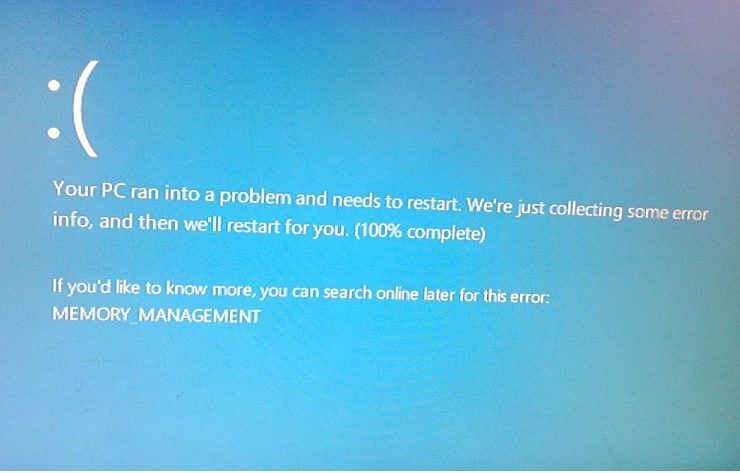
- #Windows 8 blue screen memory management drivers
- #Windows 8 blue screen memory management driver
- #Windows 8 blue screen memory management code
- #Windows 8 blue screen memory management Pc
- #Windows 8 blue screen memory management windows 8
It is usually caused by these files - iusb3hub.sys, ntoskrnl.exe, ntfs.sys, ntkrnlpa.exe, vhdmp.sys, dxgkrnl.sys, win32k.sys, tcpip.sys, or atikmdag.sys.
#Windows 8 blue screen memory management driver
This BSoD error occurs when a driver tries to write to a memory segment that is read-only on a computer. In Windows 7, you may get the computer screen saying “An attempt was made to write to read-only memory” along with stop 0x000000BE.
#Windows 8 blue screen memory management Pc
In Windows 10/8, you may get the computer screen saying your PC ran into a problem and needs to restart along with stop code: attempted_write_to_readonly_memory, as shown below:
#Windows 8 blue screen memory management code
Now, we will show you another stop code – attempted write to readonly memory. In the MiniTool website, we have shown you many blue screen errors, for example, Attempted Switch from DPC, System Service Exception Stop Code, Atikmdag.sys BSoD, Bad Pool Caller, Memory Management BSoD, etc.
#Windows 8 blue screen memory management windows 8
Generally speaking, BSoD errors always happen no matter you are using Windows 7, Windows 8 or Windows 10. Have you been bothered by a blue screen of death (BSoD) error when running your computer? Perhaps the answer is yes.

NOTE: When a STOP message occurs, Windows can create a debug file for very detailed analysis.
#Windows 8 blue screen memory management drivers
However, if you’ve installed new drivers just before the problem appeared, try rolling them back to the older ones.Make sure device drivers and system BIOS are up-to-date.

Run hardware diagnostics supplied by the manufacturer.If you’ve recently added new hardware, remove it and retest.To do this, launch EventVwr.msc from a Run box or open “Administrative Tools” in the Control Panel then launch Event Viewer. Examine the “System” and “Application” logs in Event Viewer for other recent errors that might give further clues.This checklist is also usually the best approach to troubleshooting some specific Stop messages, such as 0x0A and 0x50. If you can’t find a specific reference to your problem, running through the following checklist stands a good chance of resolving the problem for you. Real-life scenarios of a computer user encountering them are unlikely, so I’ve made it a lower priority to document them here but we’ll be happy to address this in the Forum (which also will tip me off that I should add more to this present page). STOP messages of this type are rare, obscure, and usually only of interest to programmers debugging their code.

If a message is listed below, but has no articles or explanation (nothing but its number and name), post a request on the AumHa Forums asking about it. It is the name of the error condition and its 8-digit number that help you determine the actual error condition.

The fact that a memory minidump occurred tells you nothing except what you already know - that there was an error. NOTE: Many users search this site for the word minidump which often accompanies these Stop Message errors. Four additional 8-digit hex numbers may appear in parentheses, usually unique to your computer and the particular situation. STOP messages are identified by an 8-digit hexadecimal number, but also commonly written in a shorthand notation e.g., a STOP 0x0000000A may also be written Stop 0xA. Literally mean Windows has stopped! These appear only in the NT-based operating systems: Win NT, Win 2000, Win XP, and Vista. Receive notice whenever this page is updated. Hold mouse here for list of most recent changes.


 0 kommentar(er)
0 kommentar(er)
